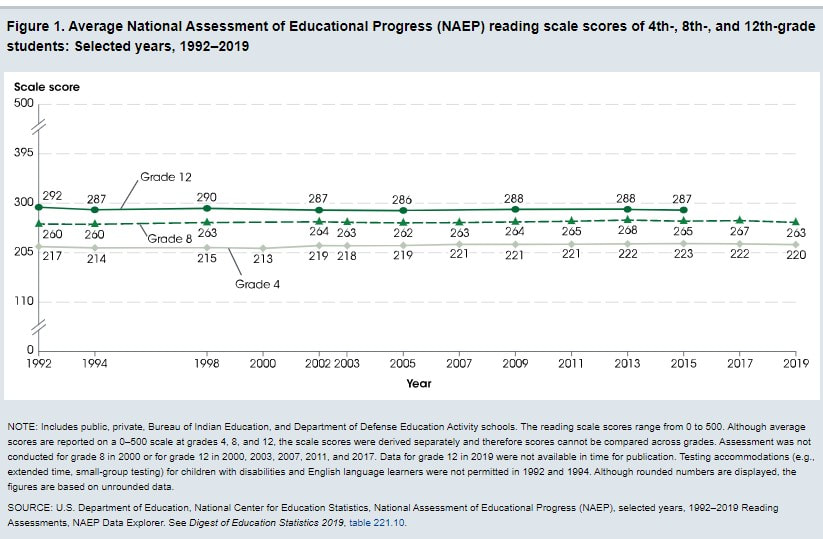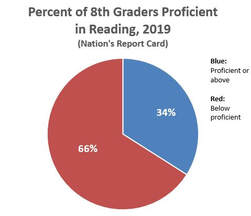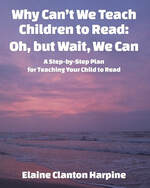
Think about it. If we spent more time counting our blessings, we wouldn't have so much free time to spend griping.
| GROUP-CENTERED PREVENTION |
|
 Happy Thanksgiving! Think about it. If we spent more time counting our blessings, we wouldn't have so much free time to spend griping.
0 Comments
 On October 24th, the National Center for Education Statistics (NCES) released scores for 8th graders for 2022. The NCES was not testing during the early days of the pandemic, so this is the first Nation’s Report Card for 8th grade since 2019. Eighth grade math scores dropped by 8 points and reading scores dropped by 3 points. The big question is always, why did scores drop? Many journalists and social media users immediately blamed COVID and school closures for the drop in test scores. Yet, that does not tell us the entire picture. There’s more to the problem. Neither the pandemic nor online instruction is the primary reason for the decline in test scores. What is the real cause of the decline in reading scores? Let’s look a little further and see what the experts are saying. Since my research and work is in reading, I will comment only on reading scores. Secretary of Education Miguel Cardona said, "What we’re seeing today isn’t just the impacts of the pandemic. ... the data prior to the pandemic did not reflect an education system that was on the right track. The pandemic simply made that worse. It took poor performance – and dropped it down even further." Why would Secretary Cardona say this? Let’s look at a NCES graph that demonstrates exactly what Secretary Cardona is talking about.  Reading scores have been stagnant or declining for years. As illustrated by this NCES chart, there has been almost no improvement in reading since 1992. The graph shows essentially a flat line. This graph records scores before the pandemic, before school closures, before online classes. This graph shows a failing educational system in reading. Yet, instead of looking at this graph and the overall failure of our educational reading program, many reporters and social media writers are trying to say that the decline is because children and youth were out of the classroom so long during the pandemic. That’s not what the experts are saying. Neither COVID nor the lockdown were the only problems that caused reading scores to drop. The National Center for Education Statistics Commissioner Peggy Carr said that, "We cannot find anything in this data that says that the results we are looking at can be solely, primarily attributable to differences in how long students stayed in remote learning…." Carr goes on to explain, “What we’re seeing is (lower performing) students... dropping even faster and we’re also seeing students who were not showing declines ― students at the top, meaning students at the higher performing levels ― they were holding steady before the pandemic or even improving …. Now all the students, regardless of their ability, are dropping. That is the point we need to be taking away from this report.” No, the experts are not denying that the pandemic had an effect. What they are saying is that, if you blame everything on COVID and school closures, then you are missing the real problem. Before COVID, 66% of 8th graders could not read proficiently. Remember “proficient” means able to read at grade level. “Below proficient” means reading below grade level.  If we are to help students overcome the pandemic losses and the devastating educational reading problems that preceded the pandemic, we must look at the real problem and stop just blaming COVID. Yes, the pandemic and online classes influenced test scores, but what the experts are saying is that we already had massive problems in reading. Over 60% of students in 4th, 8th, and 12th grade were readiing below the proficient level before COVID. It is not enought to just bring the students back up to reading where they were before COVID. We must actually teach these students how to read at grade level. As North Carolina Gov. Beverly Perdue, chair of the National Assessment Governing Board, stated, “This is not the result simply of a horrible three years for students, this is a result of a realized generational decline…. If people get this data, look at it, and think 'It's all because of the pandemic,’ then that could very well be a nearly fatal mistake for decision-making.” So, what should we do about these low test scores? Many of those same journalists and social media writers who are blaming COVID, say that there is no hope for bringing up failing students. They say that it simply can’t be done. But we can help the low achieving students catch up. If we change our teaching methods in the classroom and if we change how we tutor struggling students, we can bring all of these students up to their age level in reading. Why do I believe this? Because of my firsthand experience in working with students in the lowest 10th percentile group. Yes, a 15-year-old did learn to read before she graduated from high school. She had failed for nine straight years. The school was giving her coloring book pages to keep her busy so that she wouldn’t get into a fight. She had an extensive violence record. It wasn’t easy, but with vowel clustering she learned to read. The school had tried balanced literacy, reading recovery, and even one-on-one systematic phonics tutoring. She was reading at the pre-kindergarten level when she entered my program. She knew consonant sounds, but she did not know any of the vowel sounds when she started with me. With vowel clustering, she learned to read in 3 ½ years. Before she graduated, the school principal asked what made her stop fighting every day. The student said, “She taught me to read.” It is never too late to teach a student to read—any student. A 5th grader entered my program. He was reading between 2nd and 3rd grade with very low comprehension. He was also having trouble with aggressive behavior at school. After only 21 weeks of one-hour, once-a-week tutoring using vowel clustering, he was reading at the 6th grade level with strong comprehension scores.  These two students were both taught using my one-on-one tutoring method from my newest book: Why Can’t We Teach Children to Read: Oh, but Wait, We Can, A Step-by-Step Plan for Teaching Your Child to Read. This book has everything needed to teach any struggling student to read. It’s written for parents, teachers, and tutors. Works for all ages, even adults. I have many other success stories. These were cases where the schools had given up on these students. Both schools had announced that it wasn’t possible to teach these two struggling students. It is possible to teach struggling students to read. The problem is not the students, nor the teachers, nor the parents. It’s also not poverty or low socio-economic neighborhoods. Actually, many of the students who I teach come from the housing projects in their neighborhood. The problem is the methods that we are using to teach struggling students. The real cause of the constant decline in reading scores is that schools are using the wrong teaching methods. ________________________ For more about our failing teaching methods, read Tutoring Hint #8: Stick with Real Scientific Research in Reading. Do Not Fall for Gimmicks. Scientific Research Is Helpful for Tutoring. ________________________ So, yes, we can teach all students to read, but we probably won’t. The schools will not change. Politicians will not change. The students will continue to fail when a solution is right at our fingertips. If you have questions about vowel clustering, please contact me. If you need help with a student, feel free to contact me. I am always happy to help. |
Elaine Clanton Harpine, Ph.D.Elaine is a program designer with many years of experience helping at-risk children learn to read. She earned a Ph.D. in Educational Psychology (Counseling) from the Univ. of Illinois at Urbana-Champaign. Categories |